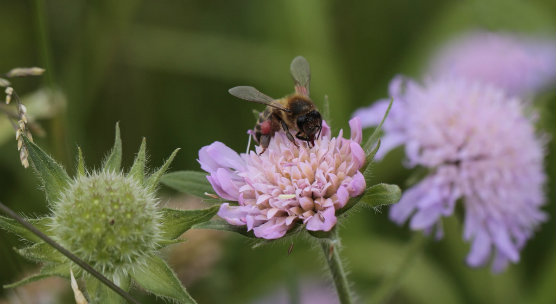Bees research shows not all neonicotinoids are the same
Published On Thu 28 Apr 2016 by Roddy Isles

The group of chemical insecticides known as neonicotinoids have been identified as presenting a serious risk to bee populations, leading to bans on their use. But at least one may be unfairly named among the offenders when it comes to risks to bumblebees, according to new research led by the University of Dundee.
The new study found that one of the neonicotinoid insecticides – clothianidin – did not show the same detrimental effects on bee colonies as its close chemical relatives imidacloprid and thiamethoxam. All three neonicotinoids have been subject to an EU-wide moratorium on their use.
Dr Chris Connolly, a Research Associate at the Centre for Environmental change and Human Rselience (CECHR) and Reader in the Division of Neuroscience at Dundee’s School of Medicine, is one of the leading authorities on the effects of neonicotinoids on bees. He has led this new study, involving both the University of Dundee and the University of St Andrews, which shows that each of the different neonicotinoids leads to differential risks for bumblebees.
“There has been growing concern over the risk to bee populations from neonicotinoid insecticides and their long-term consequences to essential ecosystem services and food security,” said Dr Connolly.
“Our knowledge of the risk of neonicotinoids to bees is based on studies of imidacloprid and thiamethoxam and these findings have generally been extrapolated to clothianidin.
“However, in this study we have looked at the three neonicotinoids in parallel. What we have found is that imidacloprid and thiamethoxam, but not clothiandin, exhibit toxicity to bumblebee colonies when exposed at field-relevant levels.
“There was also further variation in the effects on bees between the three insecticides. So we can clearly see that the banned neonicotinoids are not the same, so they should be considered independently when considering risk and legislation.
“From our findings, we consider that it is premature to place a permanent ban on the use of clothianidin. That said, a moratorium on its use should continue until the knowledge gaps are filled on its wider impact on other species.”
The researchers tested 75 bee colonies at five separate locations in Scotland.
Dr Connolly said the study once again confirmed the threat to bumblebees from use of imidacloprid and thiamethoxam.
“We have seen further evidence to indicate the risk from these insecticides, including deficits in colony strength,” he said.
“Given these findings, small changes in the pesticide structure or its target site in insects are likely to be critical to risk assessment and each pesticide/insect combination needs to be considered independently - evidence should not be extrapolated to similar chemicals or insects. Real risk must be determined empirically.”
The results of the study are published in the journal Scientific Reports.
NOTES TO EDITORS
About the University of Dundee:
The University of Dundee is the Scottish University of the Year 2016, as named by the Times & Sunday Times Good University Guide.
Dundee is internationally recognised for the quality of its teaching and research and has a core mission to transform lives locally and globally by:
- promoting the sustainable use of global resources
- shaping the future through innovative design
- improving social, cultural and physical well-being
Dundee is the top ranked University in the UK for biological sciences, according to the 2014 Research Excellence Framework.
More than 17,000 students are enrolled at Dundee, helping make the city Scotland’s most student-friendly. The University is ranked top in Scotland for student experience in the National Student Survey.
About University of St Andrews:
Founded in the 15th century, St Andrews is Scotland’s first university and the third oldest in the English speaking world.
The University is now one of Europe’s most research intensive seats of learning – over a quarter of its turnover comes from research grants and contracts. It is one of the top rated universities in Europe for research, teaching quality and student satisfaction and is consistently ranked among the UK’s top five in leading independent league tables produced by The Sunday Times and The Times, The Guardian and the Complete University Guide
According to the Sunday Times, St Andrews is “now firmly established as the leading multi-faculty alternative to Oxford and Cambridge”.
Its international reputation for delivering high quality teaching and research and student satisfaction make it one of the most sought after destinations for prospective students from the UK, Europe and overseas. It is Scotland’s most international university – a third of the student body of 7700 is from overseas.
It has a staff of 1800 and maintains one of the strongest records in the UK for teaching quality, good degrees and student support. In the eight years it has entered the UK National Student Survey, St Andrews has consistently ranked among the top five universities for student satisfaction.
For media enquiries contact:
Roddy Isles
Head of Corporate Communications
University of Dundee
Nethergate, Dundee, DD1 4HN
Tel: +44 (0)1382 384910
Mobile: 07800 581902
Email: r.isles@dundee.ac.uk